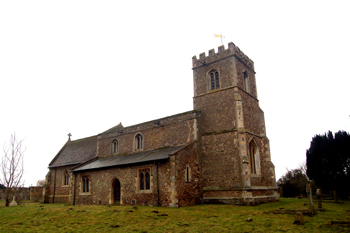
The church from the north-west February 2010
Volume 81 published by Bedfordshire Historical Records Society (2002) is a series of episcopal visitations undertaken in the first twenty years of the 18th century, edited by former County Archivist Patricia Bell. At each visitation a list of questions was sent out in advance, one of which enquired about the provision of schools in each parish. In 1706, 1709 and 1717 the Rector reported that there was no school.
In 1818 a Select Committee was established to enquire into educational provision for the poor. This was no doubt prompted, in part, by the recent foundation of two societies promoting education and specifically the building of schools. The Society for Promoting the Lancasterian System for the Education of the Poor was established in 1808 promoting schools run along the lines pioneered by Joseph Lancaster, who had himself copied those of Dr.Andrew Bell, in which older children taught their younger fellows. The Society was renamed the British and Foreign School Society in 1814,. It was supported by a number of prominent nonconformists, Lancaster himself was a Quaker, and sought to teach a non-sectarian curriculum. In answer to this perceived nonconformist takeover of local education the National Society was formed in 1811 to encourage the teaching of poor children along Anglican lines, including the catechism. The Select Committee sent a questionnaire to all parishes in the country asking for: particulars relating to endowments for the education of children; other educational institutions; observations of parish needs etc.
The Curate reported: "The Rev. Bamford, who died 1720, left £3 per annum to the minister, churchwardens and overseer of the parish, to teach 6 poor children to read and write, which has not been executed for several years past, and the income has accumulated to £35 for which the present rector pays £5 per cent interest". He continued: "A school has lately been established, in which all the children who are of sufficient age receive instruction three evenings in the week and on Sundays; the numbers amount at present to 20". In those days a Sunday School was just that, a school which met on a Sunday, usually in the church or nonconformist chapel or other similar building, teaching more than the religious topics with which they are associated today. The Curate ended his return by saying: "The poor are generally desirous that their children should be educated".
In the country generally the number of schools built continued to grow over the next fifteen years so that by 1833 the government agreed to supplement the work of the two societies, and local benefactors, by making £20,000 per annum available in grants to help build schools. It also prompted another questionnaire to be sent to each parish in England asking for details of local educational provision. The return for Little Barford read as follows: "One Daily School (commenced 1831) containing 28 children, of both sexes; it is supported by small payments from the parents of the children, and by a salary paid to the mistress by the clergyman of the parish, who also furnishes books for the use of the children. One Sunday School, endowed with £3 per annum, at which are 46 children".
The next national enquiry was in 1846/7 when the Church of England made an enquiry as to all its church schools. This was against the background of a new Whig government which championed secular education and the increasing importance of nonconformists, particularly Wesleyan Methodist, and Roman Catholics in providing schools. At that date Little Barford had a Church Sunday School of 15 boys and 15 girls as well as a daily infants' school containing nine of each sex. The return commented: "The education of this parish is attended to by the Clergyman and his family, aided by several of the most respectable inhabitants".
The first Education Act was passed in 1870 (more correctly it was known as the Elementary Education Act). It was a milestone in the provision of education in Britain demonstrating central government's unequivocal support for education of all classes across the country. It also sought to secularise education by allowing the creation of School Boards. These were groups of representatives, elected by the local ratepayers and the Board had the powers to raise funds to form a local rate to support local education, build and run schools, pay the fees of the poorest children, make local school attendance compulsory between the ages of 5 and 13 and could even support local church schools, though in practice they replaced them, turning them into Board run schools (known as Board Schools). Naturally, and luckily for local historians, the Act required a questionnaire of local schools in 1870. The return for Little Barford noted that there was a school without, meaning outside, the district, but available for Little Barford children to attend. This school lay in the Huntingdonshire parish of Eynesbury and was a National School. It had accommodation for just 22 boys, girls and infants.